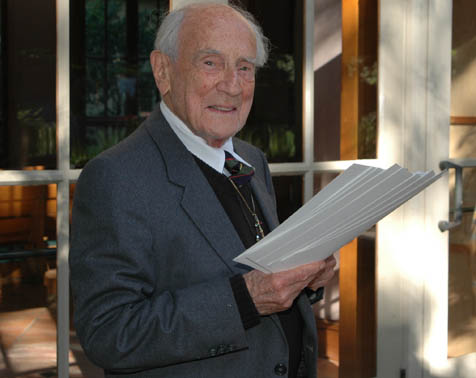John R. Seeley 1913-2007

During the ’50s and ’60s, Jack Seeley was one of the leading intellectuals, the author of classic works in sociology, an eloquent critic of authoritarian institutions, and an outspoken advocate of the youth revolt’s potential for social change. For those of us who were then young rebels, especially those of us trying to figure out how to fuse social activism and academic work, he was a voice and a model.
Born in England in 1913, Jack escaped from a cruel family situation by emigrating, penniless, to Canada. As a youth, he was a farm laborer and a printer in Canada, and he read voraciously. He saved enough to enter the University of Chicago at age 27. He served in the Canadian Army during World War II, where he worked to reform human relations in the Canadian military. After returning to Chicago for graduate studies, he spent several years immersed in developing community mental health in Canada. He never got a PhD, but this seems not to have prevented him from embarking on a very distinguished teaching and research career. He chaired the sociology departments of the newly formed York University in Toronto, and then at Brandeis.
Jack left Brandeis to live and work in Santa Barbara in the second half of the 1960s. He came here to serve as dean of the Center for the Study of Democratic Institutions, the world-famous think tank Robert Hutchins founded. The center was an intellectual home to a circle of “permanent fellows” joined by a stream of visitors, whose common task was to try to rethink American institutions. Its beginnings, during the dark days of McCarthyism, were bold and courageous; the center’s work on many issues proved widely influential. One of Seeley’s accomplishments, for example, was the convening, in Geneva, of a “Pacem in Terris” conference attended by many notables, an important peace intervention at the height of the Vietnam War.
During those years, Jack’s voice was much heard in defense of the student movement. A local instance was the afternoon of February 25, 1970, when Jack introduced William Kunstler-a lawyer for the Chicago Eight-to speak to the thousands of students assembled in UCSB’s stadium. It was after Kunstler’s appearance that police treatment of students leaving the stadium precipitated the riot in Isla Vista during which the Bank of America burned.
Seeley and others of the more politically active fellows were forced out of the center prior to those events. The UCSB Sociology Department wanted to give him a visiting position. The fact that he had published some 400 articles and several major books, and was a widely renowned figure in the field, led us to assume that such an appointment would routinely be approved. Its main benefit for Jack was some office space and library access, as well as the chance to interact with engaged scholars and students. One day, however, the parking service demanded the return of his faculty parking sticker. This led to the news that his appointment had been rejected by the chancellor.
When you look at Jack Seeley’s life story, these Santa Barbara experiences turn out to be rather typical. A few years later, he wrote in his entry in Who’s Who in America:
“I have tried to understand.
I have tried to understand in order to change.
I have had to change in order to understand.
It has been very rewarding-
and very costly.
Pain and joy have been
nicely proportioned and inextricably intertwined.
That is the nature of life.
The life-task is to say ‘yes’-and then live it.”
What he was referring to was a series of significant experiences he undertook to try to foster community, democracy, and humane practices at major academic institutions. He was one of the founders of York University, whose vision involved creating a community of faculty and students based on one-to-one teaching relationships and democratic governance. University trustees soon aborted that vision. He also tried at Brandeis, becoming chair just after the free speech movement explosion at Berkeley. Brandeis sociology faculty and students tried to create democratic community. This effort foundered when Brandeis’s administration refused to withhold students’ grades from Selective Service. Jack left for Santa Barbara, attracted by the chance to work in a self-proclaimed intellectual community. He worked to make the center live up to its claims, pushing for democratic governance and for inclusion of junior as well as senior fellows.
While litigating over the failure of the center to live up to its legal and moral promises, Jack became an active participant in another effort to create a new kind of academic institution-the Disney-funded California Institute of the Arts. CalArts’s design included the creation of a school of critical studies; Jack joined this effort, again hoping to make something that was intellectually and humanly groundbreaking. Again, as in all his other experiments, those who controlled the institution squelched the promise.
There was something quixotic about Jack’s many efforts to foster radical institutional change. But the quote above suggests that the appearance of failure, though painful, conceals a positive lesson: One way to create the basis for change is to try to make institutions live up to their moral claims. Instead of becoming cynical-that is, deciding in advance that all such claims are phony-Jack chose throughout his life to try to hold institutions accountable, to grasp possibility, and “try to live it.”
For John by Peter Marin
Now you return,
vivid in absence, filling the emptiness,
shining among the dead
like the Ideas of Plato
made bright by the Good.
As I write, a gentle rain
sets my garden gleaming with aliveness,
with Becoming,
with all that comes near in the drawing-away
of what, though gone, stays forever.
Walk with me, John. Let us pause
under the dripping of trees
as if washed clean by love.
Ahead of us, here, lie the mysteries,
the Good hidden, but blazing, above.



